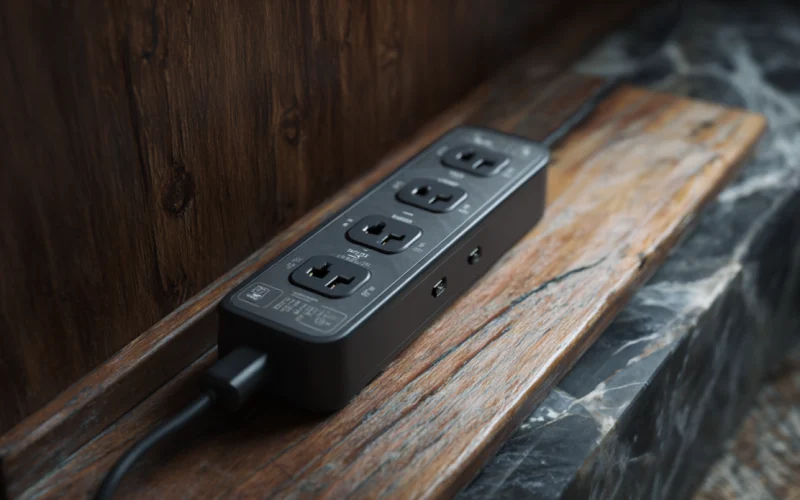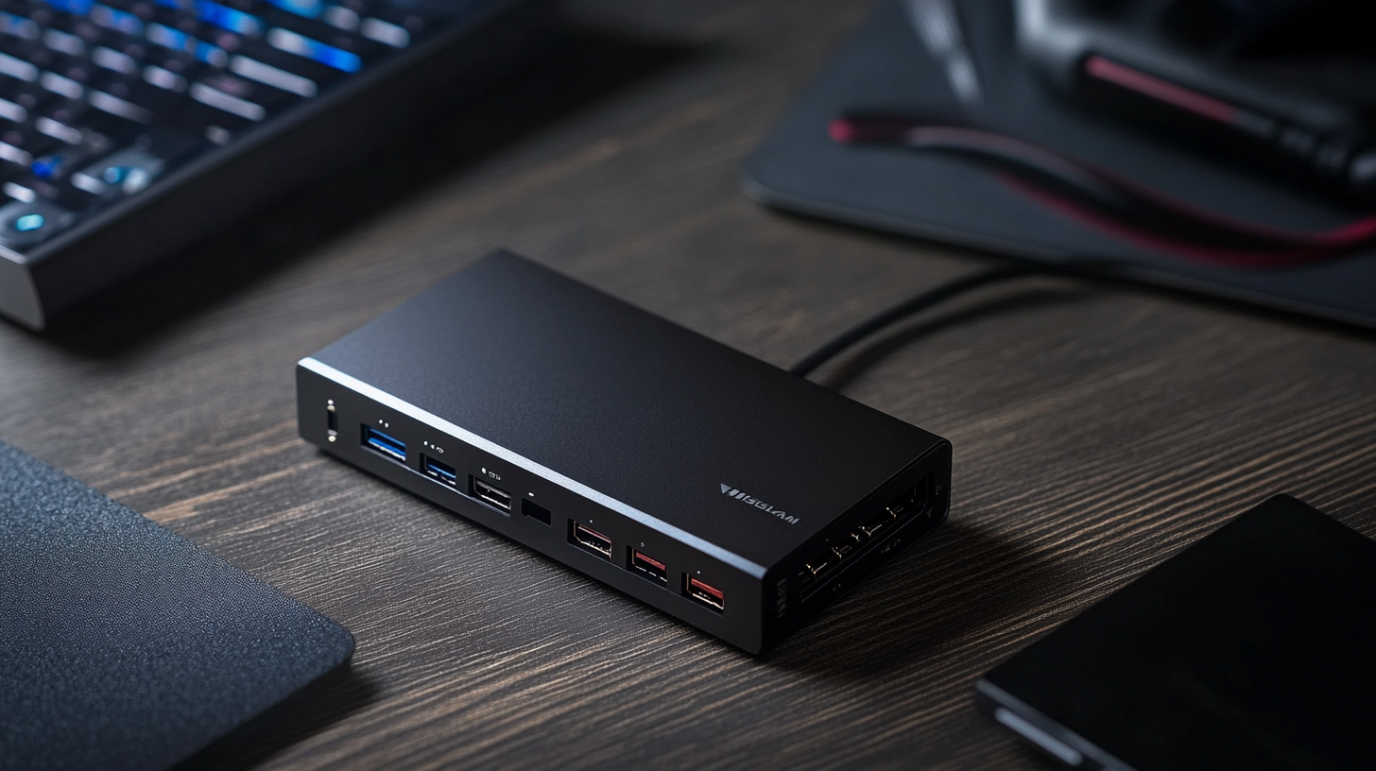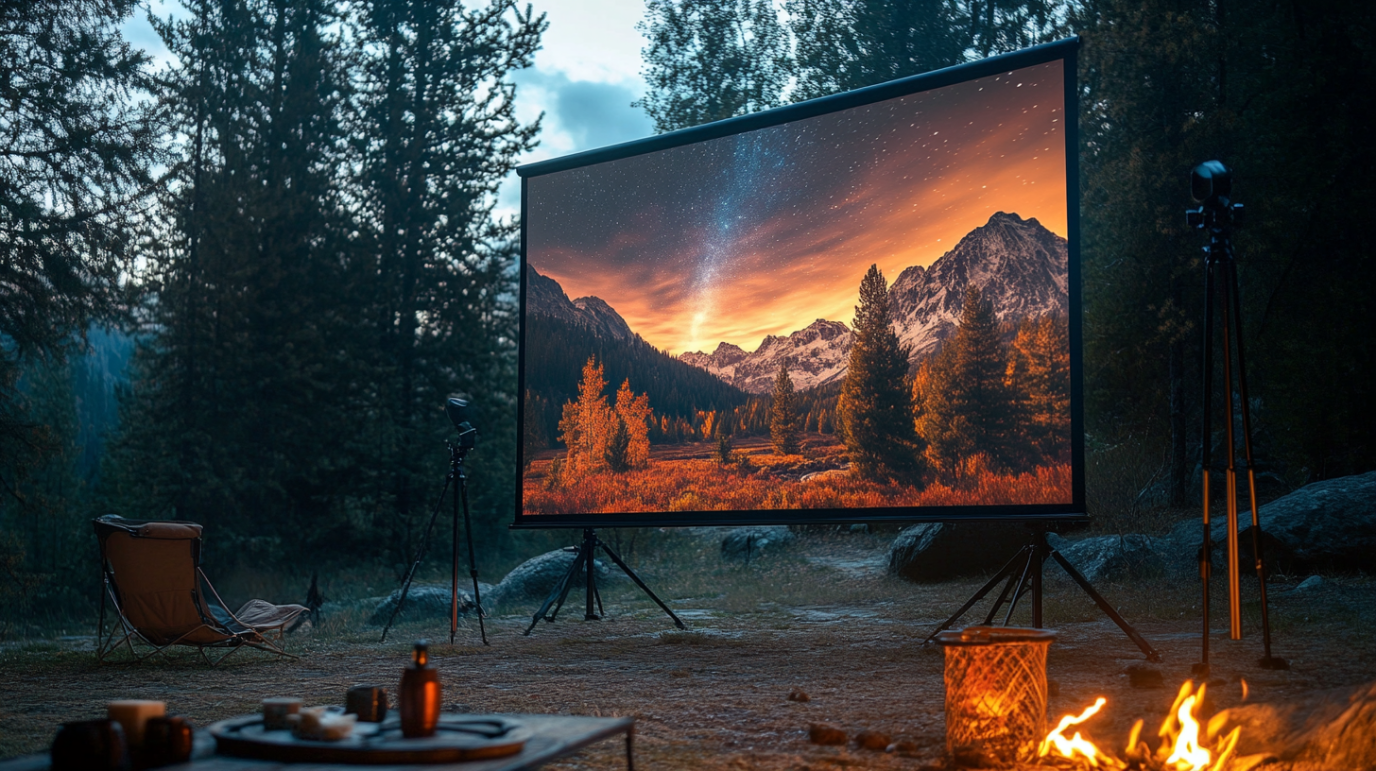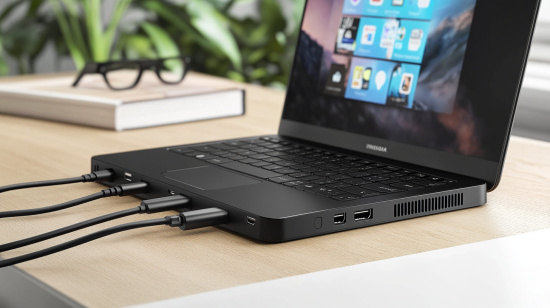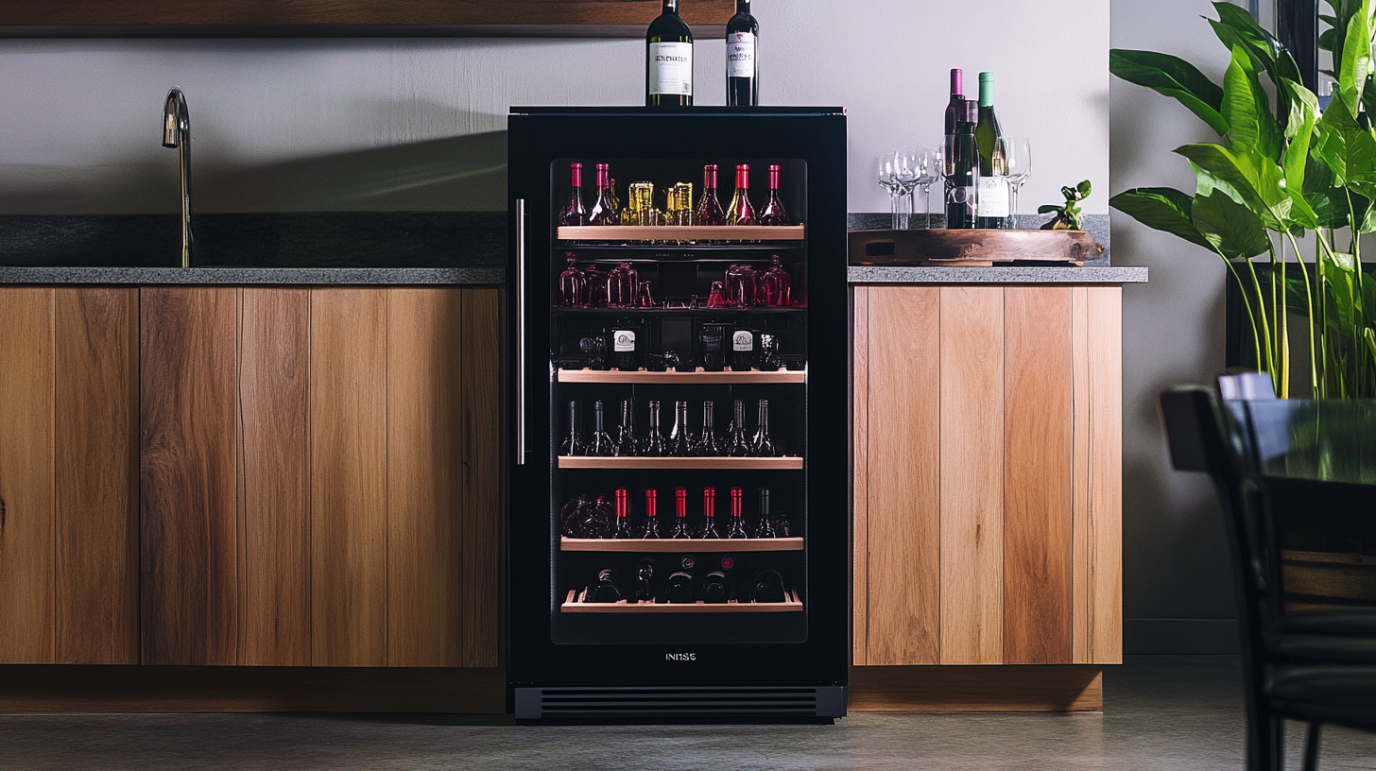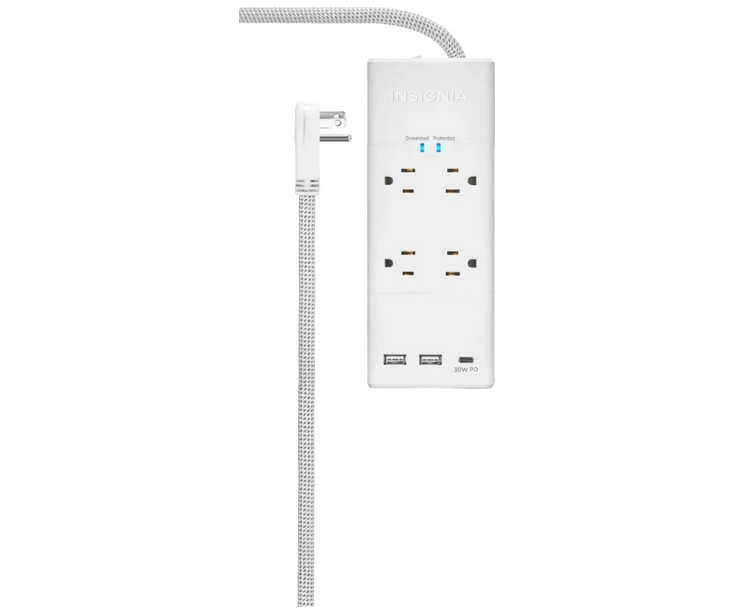
Insignia™ – 4 Outlet/3 USB 1200 Joules Surge Protector Strip – White
- 1,200 joules of protection
- Protects your connected devices against power surges up to 1,200 joules.
- 4 spaced AC outlets
- Accommodate wider plugs to power and protect several devices at the same time.
- USB-C port with Power Delivery
- The high-power 30 W USB-C port uses Power Delivery to quickly charge smartphones, tablets, laptops and other USB-C devices.
- Two USB ports
- Let you charge devices with a standard USB connection – no wall adapter needed.
- LED indicators
- Shows you when your surge protector is grounded and protecting your equipment.
- Braided power cord
- Durable and long 8 ft. cord offers flexible placement options.
- Noise filtering
- Up to 32 dB of noise filtering minimizes interference for more reliable performance.
- Brought to you by Best Buy
- Insignia brings you affordable, dependable products with all the features you need.
$29.99
Safeguarding Your Electronics Without Breaking the Bank
When the lightning flashed outside my window last summer, I wasn’t worried. Not even when the thunder crashed so loudly it seemed to shake the walls of my home office. Why? Because months earlier, I’d finally invested in proper surge protection for all my expensive electronics. After years of plugging valuable devices directly into wall outlets (I know, I know), I decided it was time to be a responsible adult and protect my investments. That decision led me down a rabbit hole of research that eventually brought me to the Insignia Surge Protector lineup—a brand that balances affordability with genuine protection.
Today, I want to share everything I’ve learned about these unassuming yet essential devices. Whether you’re setting up a home entertainment system, creating a productive workspace, or simply want to ensure your expensive electronics aren’t fried during the next electrical storm, this comprehensive guide will help you understand why the right surge protector is one of the most important investments you can make to safeguard your electronic devices.
Understanding Surge Protection: Why It Matters
Before diving into the specifics of Insignia’s offerings, let’s talk about why surge protectors matter in the first place. I used to think they were just fancy power strips—a convenient way to plug in multiple devices. Boy, was I wrong.
Power surges happen more often than you might think. They’re not just dramatic lightning strikes during thunderstorms (though those are certainly the most obvious culprits). Even smaller, daily surges from appliances cycling on and off or issues with your utility company’s equipment can, over time, damage sensitive electronics.
These voltage spikes, brief but potentially devastating, can fry circuit boards, corrupt data, and shorten the lifespan of everything from your expensive gaming console to your smart TV. In the worst cases, they can even cause fires. The financial impact of replacing damaged electronics makes the modest investment in a quality surge protector seem trivial by comparison.
What Exactly Is the Insignia Surge Protector?
Insignia is Best Buy’s in-house brand, known for offering budget-friendly alternatives to more expensive electronics and accessories without sacrificing essential features. Their surge protector line follows this same philosophy, providing reliable protection at accessible price points.
The Insignia Surge Protector range includes various models, from basic six-outlet strips to more advanced options with USB charging ports and higher joule ratings. All are designed with one primary purpose: to protect your valuable electronics from power surges by absorbing excess voltage before it reaches your devices.
What impressed me most when I first explored the Insignia line was how they managed to include important safety features while keeping prices reasonable. They’re not the flashiest or most feature-packed surge protectors on the market, but they deliver where it counts—providing genuine protection without unnecessary frills that drive up costs.
Price Range: Protecting Your Electronics Without Breaking the Bank
One of the most appealing aspects of Insignia Surge Protectors is their affordability. When I was shopping for surge protection, I was surprised by how expensive some brands were, with prices soaring well over $100 for high-end models. That’s when Insignia caught my attention.
The Insignia surge protector lineup typically ranges from around $14.99 for basic 6-outlet models to approximately $49.99 for their premium options with higher joule ratings and additional features like USB charging ports. This price range makes them accessible for most budgets while still providing legitimate protection.
During my research, I discovered that Best Buy frequently offers sales on their Insignia products, sometimes bringing the entry-level models down to under $10 during special promotions. Even at regular prices, these surge protectors represent excellent value when you consider the potential cost of replacing damaged electronics.
Where to Purchase Insignia Surge Protectors
As Best Buy’s house brand, Insignia products are most readily available at Best Buy retail locations and through their website. This exclusivity might seem limiting, but it actually makes the buying process straightforward—no need to compare prices across multiple retailers.
I purchased mine during a weekend trip to my local Best Buy, where a surprisingly knowledgeable sales associate helped me select the right model for my needs. However, I’ve found that shopping online offers certain advantages, including:
- The ability to read customer reviews
- Easy comparison between different models
- Detailed specifications for each product
- Occasional online-only discounts
- Free shipping options on orders over a certain amount
Best Buy’s website typically has a wider selection than individual stores, and you can check inventory at your local store before making the trip. They also offer curbside pickup, which I found convenient when I needed a second surge protector for my living room entertainment system.
Key Features of Insignia Surge Protectors: What to Look For
When selecting an Insignia Surge Protector, several key features deserve your attention. Understanding these specifications helped me make an informed decision, and they’ll help you too:
Joule Rating: The Measure of Protection
The joule rating is perhaps the most important specification for any surge protector. It indicates how much energy the device can absorb before failing. Think of it as the surge protector’s “energy tank”—once it’s depleted from absorbing surges, the protection diminishes.
Insignia offers models with joule ratings ranging from 900 to 4,320 joules. For reference:
- 900-1,000 joules: Suitable for basic protection of smaller electronics
- 1,800-2,500 joules: Good for computers, gaming systems, and home entertainment setups
- 3,000+ joules: Ideal for high-end equipment or complete home office protection
I opted for a 3,000-joule model for my home office where I keep my computer, external hard drives, and other expensive equipment. For my bedside table, where I only charge my phone and tablet, a 1,000-joule model proved sufficient.
Number of Outlets: Room to Grow
Insignia surge protectors come with varying numbers of outlets, typically ranging from 6 to 12. When choosing, I recommend counting your current devices and adding a few extra outlets for future needs.
Their layout matters too. Some Insignia models feature widely-spaced outlets to accommodate bulky power adapters (those annoying “wall warts” that block adjacent outlets). I particularly appreciated this feature on my entertainment center surge protector, where my gaming console, sound system, and streaming device all have chunky power bricks.
USB Charging Ports: Added Convenience
Many Insignia surge protectors include built-in USB charging ports—a feature I initially dismissed but now use daily. These ports deliver clean, regulated power to your devices while freeing up outlets for other electronics.
The premium Insignia models offer both USB-A and USB-C ports, with the latter supporting faster charging for compatible devices. My home office surge protector has two USB-A ports (5V/2.4A) and one USB-C port (5V/3.0A), which I use constantly for charging my phone, wireless headphones, and other small devices.
Cord Length: Often Overlooked But Critical
The cord length on a surge protector might seem like a minor detail until you’re rearranging furniture and discover your 3-foot cord won’t reach the nearest outlet. Insignia models typically come with cords ranging from 4 to 8 feet.
I learned this lesson the hard way when setting up my home entertainment system. The 4-foot cord on my first surge protector barely reached the wall outlet, creating an unsightly and potentially dangerous stretched cord situation. I ended up exchanging it for a model with an 8-foot cord, which gave me much more flexibility in positioning.
Additional Safety Features
Beyond basic surge protection, Insignia incorporates several safety features that impressed me:
- Automatic shutoff: When the surge protection is depleted, the unit automatically disconnects power to prevent damage to connected devices.
- Fire-resistant housing: Made from flame-retardant materials to prevent fire hazards.
- Circuit breaker: Provides overload protection, cutting power if too many devices draw too much current.
- LED indicators: Show when devices are protected and grounded properly.
These safety features gave me confidence that I wasn’t just buying a glorified power strip but a genuine protective device for my electronics.
How Insignia Surge Protectors Actually Work
Understanding how these devices function helped me appreciate their importance. Insignia surge protectors use metal oxide varistors (MOVs)—components that divert excess voltage away from your connected devices.
Under normal conditions, electricity flows through the surge protector to your devices without interruption. When a voltage spike occurs, the MOVs activate, channeling the excess electricity into the grounding wire rather than letting it flow through to your expensive electronics.
It’s worth noting that this protection isn’t infinite. Each surge a protector absorbs degrades the MOVs slightly. That’s why the joule rating matters—it represents the total amount of excess energy the surge protector can handle over its lifetime before the protection fails.
This is also why Insignia models include “protected” indicator lights. When the light is on, your devices are being safeguarded. If it goes out, it means the surge protection has been depleted, and it’s time to replace the unit even if it still functions as a power strip.
Comparing Different Insignia Surge Protector Models
After researching and testing several options, I’ve found that Insignia offers several distinct models worth considering:
Entry-Level: Insignia 6-Outlet Surge Protector (900-1,000 Joules)
This basic model represents the entry point into proper surge protection. Priced around $14.99-$19.99, it features:
- 6 standard outlets
- 900-1,000 joule rating
- 4-foot power cord
- Basic protection indicator light
- Limited warranty
I recommend this model for protecting less expensive electronics like lamps, phone chargers, or kitchen appliances. It’s also suitable for guest rooms or areas where you don’t keep valuable electronics.
Mid-Range: Insignia 8-Outlet Surge Protector with USB (2,100-2,500 Joules)
This was my first Insignia purchase, a balanced option priced around $24.99-$29.99 with:
- 8 standard outlets (some designed for bulky adapters)
- 2,100-2,500 joule rating
- 6-foot power cord
- 2 USB-A charging ports
- Protection and grounded indicator lights
- Better warranty coverage
This model works well for home entertainment systems, gaming setups, or basic home office protection. The USB ports are convenient for charging phones and tablets without using additional outlets.
Premium: Insignia 12-Outlet Advanced Surge Protector (3,000-4,320 Joules)
For my most valuable electronics, I eventually upgraded to this top-tier option, priced between $39.99-$49.99, featuring:
- 12 standard outlets (with adapter-friendly spacing)
- 3,000-4,320 joule rating
- 8-foot power cord
- 2 USB-A and 1 USB-C charging ports
- Complete indicator light system
- Coaxial and phone line protection
- Best warranty coverage
This model provides comprehensive protection for complex setups like complete home offices, high-end entertainment systems, or professional equipment. The higher joule rating offers superior protection and longer-lasting performance.
Using USB Ports: A Convenient Bonus Feature
The USB charging ports on mid-range and premium Insignia models deserve special mention. Initially, I viewed them as a nice-but-unnecessary feature. Now, I use them daily.
The standard USB-A ports on most models deliver 5V/2.4A of power, sufficient for charging most smartphones and tablets at reasonable speeds. The newer models with USB-C ports support faster charging for compatible devices at 5V/3.0A.
I’ve found these ports particularly useful for:
- Charging devices overnight without using dedicated chargers
- Providing power to smart home hubs and small accessories
- Reducing cable clutter by eliminating the need for wall adapters
- Freeing up standard outlets for larger devices
One thing to note: while convenient, these USB ports don’t provide surge protection as robust as the standard outlets. For your most valuable devices, I still recommend using the manufacturer’s charger plugged into one of the surge-protected outlets.
Warranty Protection: An Often Overlooked Benefit
One of the most compelling features of Insignia surge protectors—and one I initially overlooked—is their connected equipment warranty. This coverage promises to repair or replace your electronics (up to a specified dollar amount) if they’re damaged by a surge while properly connected to a functioning Insignia surge protector.
The warranty value varies by model:
- Basic models: Up to $75,000 connected equipment warranty
- Mid-range models: Up to $150,000 connected equipment warranty
- Premium models: Up to $300,000 connected equipment warranty
While I haven’t had to test this warranty (thankfully!), the policy demonstrates Insignia’s confidence in their products. Just be sure to register your surge protector after purchase and keep your receipt—these are typically required for warranty claims.
Home vs. Office Use: Choosing the Right Model
Your intended use should guide your selection. For my home office, where I keep expensive computer equipment and external hard drives with irreplaceable data, I opted for the premium 12-outlet model with the highest joule rating.
For home use like entertainment centers, bedrooms, or kitchen counters, the mid-range 8-outlet model often provides sufficient protection. The basic 6-outlet model works well for areas with fewer devices or less expensive electronics.
Consider these factors when deciding which model suits your needs:
- Value of connected equipment: More expensive electronics deserve higher joule ratings
- Complexity of setup: More devices require more outlets
- Critical nature of devices: Equipment with important data warrants better protection
- Space constraints: Smaller areas might benefit from compact models
Lightning Protection: Setting Realistic Expectations
Can Insignia surge protectors protect your devices during lightning storms? Yes and no. This is an area where I needed to set realistic expectations.
For indirect lightning strikes that affect power lines near your home, a quality surge protector with a high joule rating (like Insignia’s premium models) can provide effective protection. However, no consumer-grade surge protector can fully protect against a direct lightning strike to your home.
During severe storms, I still unplug my most valuable electronics as an added precaution. Think of your surge protector as the first line of defense, not an impenetrable shield against Mother Nature’s most extreme electrical events.
Energy Efficiency: Reducing Phantom Power Draw
One concern I had when adding multiple surge protectors to my home was increased energy consumption. I was pleased to discover that many Insignia models include energy-saving features to address this issue.
Some models offer switched outlet banks that allow you to completely cut power to certain outlets while leaving others active. This helps combat “phantom power draw”—the electricity devices consume even when turned off or in standby mode.
While the energy savings are modest (typically a few dollars per year), these features align with my efforts to reduce unnecessary power consumption. The premium models seem to offer the best energy-saving features, though even the basic models are designed with efficiency in mind.
Indicator Lights: Understanding What They Mean
The LED indicators on Insignia surge protectors aren’t just decorative—they provide important information about the protection status:
- Protected/Surge indicator: When lit, this confirms your devices are receiving surge protection. If it goes out while the unit is still providing power, the surge protection has been depleted, and the unit should be replaced.
- Grounded indicator: This light confirms your outlet is properly grounded, which is essential for the surge protector to function correctly. If this light isn’t on, consult an electrician, as your home wiring may have grounding issues.
- Power indicator: Simply confirms the unit is receiving power from the wall outlet.
I check these indicators periodically, especially after known power events, to ensure my protection remains active. It’s an easy maintenance habit that helps maintain peace of mind.
Compatible Devices: What to Connect (and What Not To)
Insignia surge protectors are designed to protect most household electronics, including:
- Computers, monitors, and peripherals
- Television sets and gaming consoles
- Audio equipment and speakers
- Routers and networking equipment
- Mobile device chargers
- Lamps and small appliances
However, certain high-power devices should not be connected to surge protectors:
- Large appliances like refrigerators, washing machines, or microwaves
- Space heaters or air conditioners
- Power tools or shop equipment
- Medical equipment (unless specifically approved)
These high-draw devices can overwhelm standard surge protectors, potentially creating a fire hazard or damaging the surge protection components. They should be plugged directly into appropriate wall outlets.
Troubleshooting Common Issues
Even reliable products occasionally have issues. Over my years using Insignia surge protectors, I’ve encountered and resolved several common problems:
No Power to Connected Devices
If your surge protector isn’t delivering power to connected devices:
- Check if the surge protector is plugged into a working outlet
- Verify the power switch is in the “on” position
- Inspect the circuit breaker button—it may have tripped due to overload
- Examine the power cord for damage
In my experience, the most common cause is a tripped circuit breaker, usually from connecting too many high-draw devices simultaneously. Reducing the load and resetting the breaker typically resolves the issue.
Protection Indicator Light Is Off
If the “protected” indicator light goes out:
- Try a different wall outlet to rule out grounding issues
- If the light remains off, the surge protection has likely been depleted
- Continue using the device only as a temporary power strip
- Replace the surge protector as soon as possible
When I noticed the protection light was off on my bedroom surge protector, I initially thought it was defective. After testing it in different outlets, I realized it had simply absorbed its lifetime capacity of surges and needed replacement.
USB Ports Not Charging
If the USB ports aren’t charging properly:
- Try different USB cables to eliminate cable issues
- Check if the device draws more power than the ports provide
- Ensure no debris is blocking the USB connections
- For persistent issues, contact Insignia customer support
I once had issues with slow charging from the USB ports, which I resolved by using higher-quality cables. The stock charging cables that come with many devices are often subpar.
Real-World Performance: My Experience with Insignia
After using Insignia surge protectors throughout my home for over two years, I can report generally positive experiences. During a particularly severe thunderstorm last summer, we experienced multiple power flickers and at least one significant surge that caused my neighbor’s unprotected television to fail.
My electronics, protected by Insignia surge protectors, continued functioning without issue. While this anecdotal evidence isn’t scientific, it reinforced my confidence in these affordable protective devices.
The build quality has proven satisfactory, with no physical deterioration despite regular use. The outlets maintain good tension, securely holding plugs without becoming loose over time. The power switches and circuit breakers continue to function as expected.
My only minor complaint involves the USB charging ports, which don’t deliver the fastest possible charging speeds for newer devices. However, they’re perfectly adequate for overnight charging or topping up devices throughout the day.
Customer Reviews: What Others Are Saying
While my experience has been positive, I also researched other customers’ experiences before writing this guide. The consensus among reviewers seems to align with my findings:
Positive feedback frequently mentions:
- Excellent value for the price
- Reliable protection during power events
- Convenient features like widely-spaced outlets
- Good build quality compared to generic alternatives
Critical reviews typically focus on:
- USB charging speeds slower than dedicated chargers
- Limited color options (mostly black or white)
- Bulkier design compared to premium brands
- Occasional defective units (as with any mass-produced product)
The overall ratings for most Insignia surge protectors hover between 4.3 and 4.7 out of 5 stars based on thousands of reviews—impressive scores that support my recommendation of these products.
Seasonal Discounts and Promotions
If you’re considering purchasing an Insignia surge protector, timing your purchase might save you money. Best Buy frequently offers discounts on their house brand products during several key shopping periods:
- Back-to-school sales (August-September)
- Black Friday and Cyber Monday (November)
- After-Christmas clearance (December-January)
- Random weekend sales throughout the year
I’ve seen discounts ranging from 20% to 40% off regular prices during these promotions. Additionally, Best Buy occasionally offers bundle deals when purchasing multiple surge protectors or buying them alongside other electronics.
My strategy has been to purchase these during sales and keep a spare on hand. Since surge protectors eventually wear out (as their joule capacity is depleted by absorbing surges), having a replacement ready prevents leaving valuable electronics unprotected.
Final Thoughts: Why I Recommend Insignia Surge Protectors
After extensive research and personal experience with various models, I confidently recommend Insignia surge protectors for most home and small office needs. They strike an excellent balance between affordability and genuine protection, offering features typically found in much more expensive brands.
The key advantages that have made me a repeat customer include:
- Solid protection ratings at accessible price points
- Thoughtful design features like widely-spaced outlets
- Reliable performance during actual power events
- Excellent warranty coverage for connected equipment
- Convenient purchasing through Best Buy
While they lack some premium features of high-end brands, Insignia surge protectors deliver where it matters most: providing reliable protection for your valuable electronics at prices that make proper surge protection accessible to everyone.
Whether you’re protecting a sophisticated home theater, a productive home office, or simply charging your everyday devices, Insignia offers an appropriate model at a reasonable price. In a world where our reliance on electronics continues to grow, that peace of mind is invaluable.
Remember: the cost of a quality surge protector is trivial compared to the value of the devices it protects. Don’t wait until after a devastating power surge to realize this essential truth—I learned it the hard way so you don’t have to.

